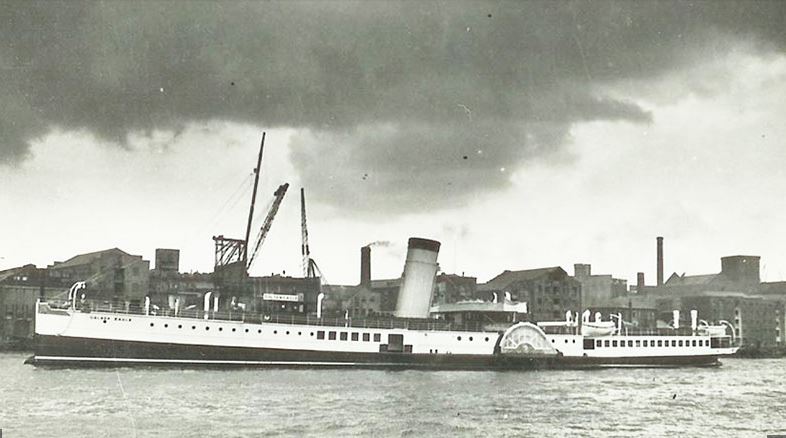Difference between revisions of "HMPS Golden Eagle"
From Our Contribution
| Line 1: | Line 1: | ||
| − | {{Infobox | + | {{Infobox ship |
| − | | | + | | image = [[File:HMT_Golden_Eagle.jpg]] |
| − | |||
| − | |||
| − | |||
| − | |||
| − | |||
| − | |||
| caption = | | caption = | ||
| − | | | + | | image2 = [[File:.jpg]] |
| caption2 = | | caption2 = | ||
| − | + | | shipname = HMPS Golden Eagle | |
| − | + | | shipowner = The General Steam Navigation Co Ltd, London | |
| − | + | | shipbuilder = John Brown, Clydebank | |
| − | + | | shipyardnumber = 386 | |
| − | + | | shiplaunched = 17 Apr 1909 | |
| − | | | + | | shipcompleted = 9 Jun 1909 |
| − | + | | shipinservice = 1909 | |
| − | | | + | | shipoutofservice = 1949 |
| − | | | + | | shipinservice2 = |
| − | + | | shipoutofservice2 = | |
| − | | | + | | shipreclassified = |
| − | | | + | | shipID = |
| − | + | | shipfate = broken up in 1951 | |
| − | | | + | | shiptype = passenger paddle steamer |
| − | | | + | | shiptonnage = 793 tons |
| − | + | | shiplength = 275.7 ft (84.0m) | |
| − | | | + | | shipbeam = 32.1 ft (9.78m) |
| − | | | + | | shipdepth = 10.1 ft (3.08m) |
| − | + | | shippropulsion = two paddle wheels | |
| − | | | + | | shipspeed = |
| − | | | + | | shipcapacity = |
| − | |||
| − | | | ||
| − | | | ||
}} | }} | ||
| Line 39: | Line 30: | ||
==Remarks== | ==Remarks== | ||
Owners were the General Steam Navigation Company Ltd. Regular run was London to north Kent resorts (Margate and Ramsgate). | Owners were the General Steam Navigation Company Ltd. Regular run was London to north Kent resorts (Margate and Ramsgate). | ||
| − | Served furing WW1 as a troop carrier between Jan 1915 and Nov 1919 during which time she carried 518,101 men across the English Channel. | + | Served furing WW1 as a troop carrier between Jan 1915 and Nov 1919 during which time she carried 518,101 men across the English Channel. Also carried stores and early aircraft to France. She was in the process of being converted to a mine layer when the war ended. |
| − | Also carried stores and early aircraft to France. | + | |
| − | Used | + | Used in January 1940 to act as an anti-aircraft ship and to evacuate soldiers (1,751) from Dunkirk, and later more than 3,000 London children to Great Yarmouth on the east coast of England. Also used as an anti-aircraft ship in the Thames. Returned to her owners in June 1945, she was used initially as am accommodation ship before returning to normal service until she was laid up in 1949. Broken up by Thmas W Ward Ltd at Grays, Essex in 1951, |
| − | |||
==List of soldiers carried== | ==List of soldiers carried== | ||
===Folkestone to France 17 Dec 1916=== | ===Folkestone to France 17 Dec 1916=== | ||
| − | *[[John (Senior) Shepherd]] | + | * [[John (Senior) Shepherd]] |
===Folkestone to France 25 Feb 1917=== | ===Folkestone to France 25 Feb 1917=== | ||
| − | *[[Thomas Ramsell]] | + | * [[Thomas Ramsell]] |
[[Category:Ships]] | [[Category:Ships]] | ||
Revision as of 14:25, 22 October 2021
 | |
| File:.jpg | |
| History | |
|---|---|
| Name | HMPS Golden Eagle |
| Owner | The General Steam Navigation Co Ltd, London |
| Builder | John Brown, Clydebank |
| Yard number | 386 |
| Launched | 17 Apr 1909 |
| Completed | 9 Jun 1909 |
| In service | 1909 |
| Out of service | 1949 |
| Fate | broken up in 1951 |
| General characteristics | |
| Type | passenger paddle steamer |
| Tonnage | 793 tons |
| Length | 275.7 ft (84.0m) |
| Beam | 32.1 ft (9.78m) |
| Depth | 10.1 ft (3.08m) |
| Propulsion | two paddle wheels |
Contents
Remarks
Owners were the General Steam Navigation Company Ltd. Regular run was London to north Kent resorts (Margate and Ramsgate). Served furing WW1 as a troop carrier between Jan 1915 and Nov 1919 during which time she carried 518,101 men across the English Channel. Also carried stores and early aircraft to France. She was in the process of being converted to a mine layer when the war ended.
Used in January 1940 to act as an anti-aircraft ship and to evacuate soldiers (1,751) from Dunkirk, and later more than 3,000 London children to Great Yarmouth on the east coast of England. Also used as an anti-aircraft ship in the Thames. Returned to her owners in June 1945, she was used initially as am accommodation ship before returning to normal service until she was laid up in 1949. Broken up by Thmas W Ward Ltd at Grays, Essex in 1951,